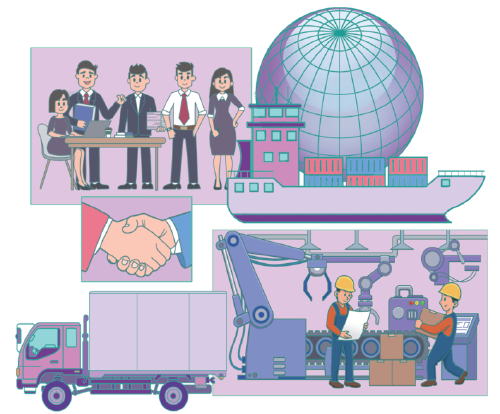Global connections
The ties that bind in an interconnected world are evolving not retreating

The ties that bind in an interconnected world are evolving not retreating

Over the past 40 years, our world has become ever more interconnected. Today, no region is close to self-sufficient and all benefit from our global connections. However, the increasing stress on the global flows of goods and services in the past two years has prompted speculation that the world is deglobalizing. The reality is more nuanced. New McKinsey Global Institute research investigating over 30 value chains and 6,000 products suggests that global integration is evolving rather than retreating.
China has been a key driver of the trajectory of global connections for the past three decades, and is likely to continue to be so. Since joining the World Trade Organization in 2001, China has become more prominent in international trade. When it joined, it accounted for 7 percent of global exports. That share has now doubled and China has been the world's largest exporter in the world since 2009. Since 1995, China has gained more share than any other economy of export value added in 15 out of 18 manufacturing value chains, including electronics, textiles, basic metals and chemicals. For these four, China today accounts for at least 25 percent of the total value added that crosses borders.
While China has increasingly localized many of its value chains over the past decade and started consuming more of what it produces, it continues to be deeply interdependent with the rest of the world. China sources around 10 percent and 25 percent of its key crop and energy needs, respectively, from outside its borders. It is also a net importer of products in high value-added sectors such as transportation equipment and pharmaceuticals.
Even in sectors where China is a net exporter, it often sources from other nations important technologies. For example, while China accounts for virtually all of the world's refining of natural graphite for use in electric vehicle batteries, it relies on technologies from Japan and the Republic of Korea for some of the critical processing steps, including coating application.
Interdependencies flow both ways. Most economies in the world rely on China for many of the goods (ranging from raw materials, important intermediaries or final products) they need. China is, for example, the leading producer of many goods in the electronics, textiles, and contract manufacturing sectors. China accounts for more than half of the global supply of products in these sectors that are only sourced from a few geographies — products which exhibit concentrated trade relationships.
In many cases, this concentration has been the result of economic considerations, notably the search for scale or specialization. Nonetheless, given the risk of disruption to supply chains, it is likely businesses will seek to balance efficiency and resilience.
And as a result, it is likely that value chains will gradually reconfigure. Our analysis shows that, in the past 25 years, individual countries gained (or lost) no more than 2 percent of export share a year (annualized), and value chains cumulatively shifted by about 10 to 20 percent per decade.
Even when shifts occur, in highly integrated global value chains, moving one piece doesn't mean moving the whole puzzle. Consider the textiles trade and the United States and China. Since 2016, the United States has moved around 4 percentage points of import share from China to other partners in Southeast Asia. However, these partners increasingly rely on inputs and intermediates from China. The result is that, from a value-added perspective, China's share of textiles exports to the United States has actually slightly increased.
Shifts in some value chains may accelerate, particularly those considered to have strategic importance and therefore subject to more active policy influence. One example is the move by several economies, including China's, to develop more domestic production of semiconductors.
Another broad shift that is already underway is that cross-border flows of intangibles rather than physical goods are becoming ever more prominent in our digitizing world. Over the past decade, trade in goods relative to economic growth has stabilized (at a high level) and, between 2010 and 2019, flows of services, international students, and intellectual property grew about twice as fast as goods flows.
In many of these intangibles flows, China still has significant opportunities to increase its level of global participation. While China accounts for about 15 percent of global goods exports, it accounts for less than 5 percent of service exports. China is currently a larger destination than origin for IP flows, accounting for around 5 percent of all inbound flows of IP but less than 1 percent of outbound flows. Similarly, China is a far larger origin of young talent outflows than inflows, accounting for 25 percent of all outbound international students against 5 percent of inbound students.
How are international businesses likely to react to this new phase of globalization and how might this affect China? Although every region in the world is interdependent, disruptions to supply chains in recent years have prompted many multinationals to reconsider their China approach. Broadly, we see "three Ds" as possibilities — these are not mutually exclusive and corporations may pursue several in tandem. The first is to go domestic and insulate to an extent their business in China either by selling part of it to Chinese companies, by spinning off a Chinese business, or by localizing all inputs and sales. The second "D" is diversification to develop alternative flows of critical capabilities and resources to and from China, thereby building resilience. Diversifying companies may offshore some production capacity to other regions and countries. But the third "D" is doubling down on China — some leading companies in the growing electrical vehicle and chemical sectors are expanding their manufacturing footprint in China to develop local competitiveness and capitalize on local innovations even as they maintain their global connections.
Overall, global integration appears to be evolving rather than retreating. The challenge for all economies is to understand the changes that are happening, and look for new opportunities even while shoring up resilience.
Jonathan Woetzel is a senior partner in McKinsey's Shanghai office and the director of McKinsey Global Institute. Jeongmin Seong is the partner of McKinsey Global Institute at McKinsey& Co. The authors contributed this article to China Watch, a think tank powered by China Daily.
Contact the editor at editor@chinawatch.cn.


































